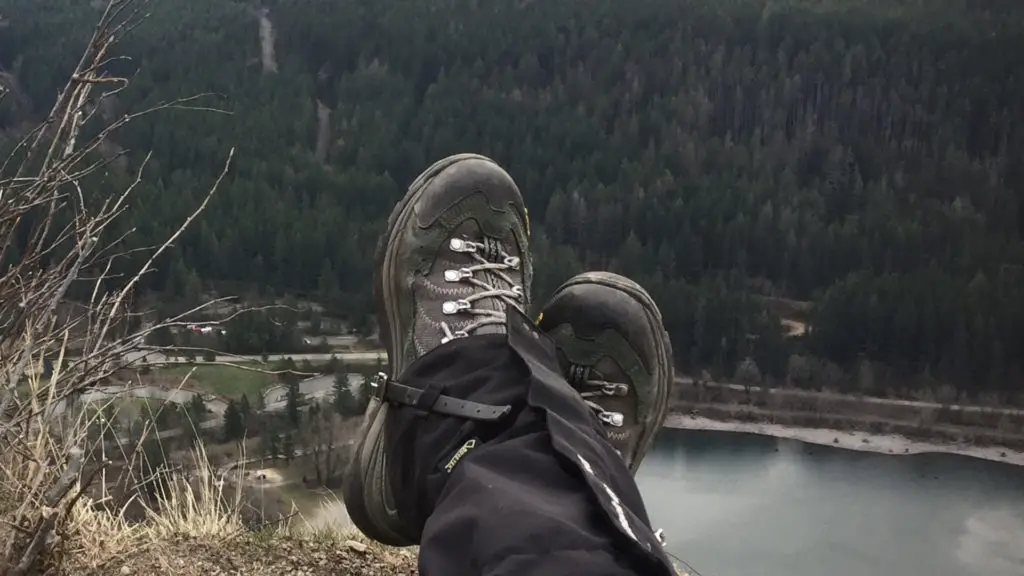Like trail runners, a basic day-hiking boot can be used for anything from a couple miles on mild inclines to long days with steep scree and minor scrambling, but the key thing that separates them from trail runners is the ankle support. Your day-hiking boot prevents any sideways movement and helps you stabilize on uneven terrain; a rolled ankle can be a real day-ruiner or worse, and is one of the most common injuries on the trail. Day-hiking boots usually weigh in around two pounds per pair, significantly less than backpacking or mountaineering boots, which weigh up to three times that. Normally there is a wide selection of colors and styles and the option of going with a fully waterproof Gore-Tex boot, or a more breathable but non-waterproof boot. Materials are most often synthetic or a mix of leather/suede and manmade, allowing them to be hearty while staying light and relatively flexible. These boots will likely serve you well for 500-700 miles before they need replacing. This is your commuter car, your daily workhorse.
Features
- Ankle support: Whether full or mid height, ankle stability is the main feature separating shoes from boots
- Lugged sole: A nubby Vibram sole gives you traction on dirt and gravel
- Rock plate: Hard plastic inserts situated between the midsole and outsole of the boot help prevent injury or discomfort from sharp rocks
- Toe bumpers/full or partial rands: Rubber or other abrasion-resistant material wrapped around where the upper and the sole join
- Material: Usually synthetic, sometimes suede or leather
- Gore-Tex: Optional. Depending on your climate and the kind of hiking you’ll be doing, weigh waterproof and warm vs. breathable. Generally speaking, waterproof is going to give you more destination options, but if you live in a hot dry climate it’s wise to go with breathability
- Weight: Averages around two pounds per pair
- Lacing system: Multiple hooks and grommets give you numerous options to personalize your fit and feel
Uses
- Cold weather
- Snow, rain, mud, sand, ash
- Carrying a heavy load
- Rough terrain where an ankle roll is a hazard
- Travel in areas with sharp rocks, downed trees, bushwhacking
- Walking up and down steep inclines
- Coming back from an injury and need extra support
Spending a couple hours trying on boots is not unusual, and it’s imperative for your day hikers, which you could potentially wear several times a week year round, to fit you well. Try them on with the socks you’ll typically be wearing, at the end of the day when your feet are a little puffier than they are in the morning, and don’t be afraid to ask a million questions. Your performance and enjoyment depend on getting this right. I’ve never been a fan of the term “go-to,” but this type of boot is so versatile and adaptable that you may wind up doing everything from jogging in them to strapping crampons onto them, so if you could only get one type of hiking footwear (and it’s not for a multi-month excursion or glacier travel in freezing weather) this is, I’m gonna say it: your go-to.
Popular Day Hiking Boots For Women
- Merrill Moab
- Solomon X Ultra 3
- La Sportiva Nucleo
- Oboz Sapphire
- Keen Targhee 3

Wendy Harrington is a California native who has lived in a small town at the foothills of the Cascade Mountains in Washington state since 2001. Her love of trail running and peakbagging has led her to summit all five Washington volcanoes, climb to the high points of three states, and put nearly a thousand miles a year on her boots. Her loves include ridgelines, saddles, granite, one-day pushes on big mountains, anything volcanic, long solo days, and objectives that push limits and test endurance.

